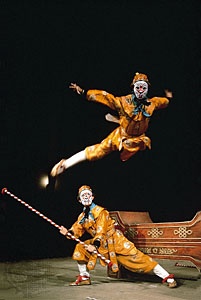jingxi
Chinese theatre
Chinese“opera of the capital”, Wade-Giles romanization ching-hsi, English Peking opera
 popular Chinese theatrical form that developed in the mid-19th century. It incorporated elements of huidiao from Anhui, dandiao from Hubei, and kunqu, the traditional opera that had predominated since the 14th century. Sung in Mandarin, the dialect of Beijing (Peking) and of the traditional elite, the jingxi musical verse plays came to be performed throughout China, although most provinces and many major cities developed their own operatic variants using local dialect.
popular Chinese theatrical form that developed in the mid-19th century. It incorporated elements of huidiao from Anhui, dandiao from Hubei, and kunqu, the traditional opera that had predominated since the 14th century. Sung in Mandarin, the dialect of Beijing (Peking) and of the traditional elite, the jingxi musical verse plays came to be performed throughout China, although most provinces and many major cities developed their own operatic variants using local dialect. Jingxi is highly conventionalized. The attitudes of individual characters are encoded in traditional steps, postures, and arm movements. The actors and actresses wear elaborate face paint to show the characters they play. Acrobatic movements are frequently used to suggest violent action. Accompaniment is provided by a small orchestra of stringed and wind instruments, wooden clappers, and a small drum. Interludes of spoken narration permit singers to rest periodically during the characteristically lengthy performances. Jingxi traditionally employed an all-male cast with female impersonators, but in the late 20th century it expanded its scope to admit female actors. The most renowned jingxi performer was Mei Lanfang, who played mostly female roles; he introduced the art form to an international audience by touring in Japan, the United States, and the Soviet Union.
Jingxi is highly conventionalized. The attitudes of individual characters are encoded in traditional steps, postures, and arm movements. The actors and actresses wear elaborate face paint to show the characters they play. Acrobatic movements are frequently used to suggest violent action. Accompaniment is provided by a small orchestra of stringed and wind instruments, wooden clappers, and a small drum. Interludes of spoken narration permit singers to rest periodically during the characteristically lengthy performances. Jingxi traditionally employed an all-male cast with female impersonators, but in the late 20th century it expanded its scope to admit female actors. The most renowned jingxi performer was Mei Lanfang, who played mostly female roles; he introduced the art form to an international audience by touring in Japan, the United States, and the Soviet Union.Since the 1970s, several jingxi troupes have performed in the West. The acclaimed film Bawang bieji (1993; Farewell My Concubine) features two main characters who are jingxi actors.
- Abington, Fanny
- Abipón
- Abish, Walter
- Abitibi River
- Abkhaz
- Abkhazia
- Abkhazo-Adyghian languages
- Ableman v. Booth
- Ablett, Gary
- ablution
- Abner Doubleday
- Abney, Sir William de Wiveleslie
- ABO and Rh groups in transfusion
- ABO blood group system
- Abolhasan Bani-Sadr
- abolitionism
- Abolqasem al- Khoei
- Abomey
- Abominable Snowman
- Abong Mbang
- abortion
- Pindari
- Pindaric ode
- Pindar, Peter
- Pindemonte, Ippolito